Volkswagen Taos: Parking and maneuvering
- Parking the vehicle
- Information about the parking systems
- Park Distance Control (PDC)
- Rear View Camera (Rear View)
- Rear Traffic Alert
- Braking assistance systems
Parking the vehicle
Parking
1. Press and hold the brake pedal.
2. In vehicles with an automatic transmission, move the selector lever into the P position.
3. Set the electronic parking brake.
4. On uphill and downhill slopes, turn the steering wheel so that the vehicle will roll into a curb if it begins moving.
5. Stop the engine and switch the ignition off.
The red
 indicator light in the
instrument cluster display will turn on ⇒
indicator light in the
instrument cluster display will turn on ⇒
 .
.
6. Release the brake.
7. To engage the steering lock, you may need to turn the steering wheel slightly.
8. Exit the vehicle ⇒
 . Pay
attention to other road users.
. Pay
attention to other road users.
9. Take all vehicle keys with you and lock the vehicle.
WARNING
Parking the vehicle incorrectly can result in the vehicle rolling, even on slight downhill slopes. Accidents and serious or fatal injuries could result.
- Before exiting the vehicle, make sure the electronic parking brake is
activated and the red warning light
 comes on in the Volkswagen Digital Cockpit display once the ignition has
been switched off.
comes on in the Volkswagen Digital Cockpit display once the ignition has
been switched off. - Ignition switch: Never remove the remote vehicle key from the
ignition switch when the vehicle is in motion.
Otherwise, the steering lock could engage suddenly. Then you would not be able to steer the vehicle.
- hen parking the vehicle, always follow the steps in the specified order.
WARNING
If you leave children, people requiring assistance or animals unattended in the vehicle, they may accidentally set the vehicle in motion or be subjected to very high or low temperatures.
There is a risk of accidents and serious or fatal injuries.
- Never leave children, people requiring assistance or animals unattended in the vehicle.
Parking spaces and surroundings
To avoid damage and dangerous situations, always park the vehicle in a
suitable parking area ⇒
 .
.
NOTICE
Any unevenness in the ground, as well as sand or mud, may prevent the vehicle from being parked safely. This can result in damage to the vehicle.
- Always park the vehicle on firm and level ground.
NOTICE
Vehicle components that are low to the ground such as the bumpers, spoilers, and parts of the suspension may collide with objects protruding up from the ground when they are driven over. The vehicle can be damaged.
- Drive carefully over driveways, ramps, curbs and fixed barriers, as well as when driving through dips.
Rear seat information
The function depends on the vehicle equipment.
If the ignition is switched off, a message appears in the Infotainment system to
remind you not to leave behind passengers in
the rear seats ⇒
 .
.
If a rear door was used prior to driving, a message will also be displayed in the instrument cluster and a warning tone will sound if necessary. The warning tone can be set in the vehicle settings of the Infotainment system.
 Rear seat information muted.
Rear seat information muted.
Electronic parking brake
The electronic parking brake secures the parked vehicle to prevent it rolling away. It can be used to brake the vehicle in an emergency.
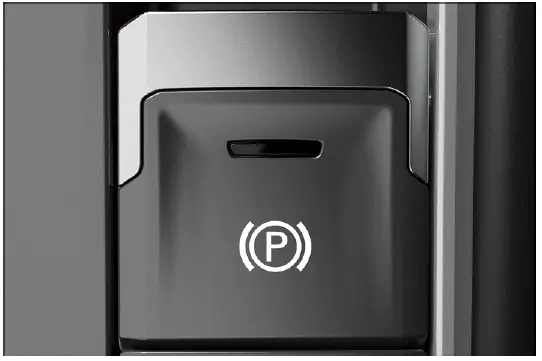
Fig. 121 In the center console: button for the electronic parking brake.
Switching on
 The red warning light in the
instrument cluster comes on when the vehicle is held securely in place.
The red warning light in the
instrument cluster comes on when the vehicle is held securely in place.
1. When the vehicle is stationary, pull and hold the button for the
electronic parking brake
 fig. 121.
fig. 121.
The yellow indicator light in the
 button comes on and the red
button comes on and the red
 warning light in the instrument cluster comes on.
warning light in the instrument cluster comes on.
The electronic parking brake is engaged.
Switching off
1. Switch the ignition on.
2. Press the brake pedal and press the
 button.
button.
The indicator light in the
 button
and the red
button
and the red
 warning light in the
Volkswagen Digital Cockpit will turn off.
warning light in the
Volkswagen Digital Cockpit will turn off.
Automatic switch-on if you leave the vehicle incorrectly
On vehicles with an automatic transmission, if the system detects that the
vehicle has been exited improperly, it can switch on
the electronic parking brake automatically ⇒
 .
.
WARNING
Parking the vehicle incorrectly can result in the vehicle rolling, even on slight downhill slopes. Accidents and serious or fatal injuries could result.
- When parking the vehicle, always follow the steps of the parking procedure in the specified order ⇒ Parking.
- Before exiting the vehicle, make sure the electronic parking brake is
activated and the red
 warning light in
the Volkswagen Digital Cockpit display comes on after switching off the
ignition.
warning light in
the Volkswagen Digital Cockpit display comes on after switching off the
ignition.
Automatic switch-off when starting to drive
If one of the following situations occurs when the driver door is closed, the
electronic parking brake will release automatically
as you drive off ⇒
 :
:
- Automatic transmission: A gear is engaged and the accelerator pedal is pressed.
WARNING
If the accelerator pedal is accidentally pressed when the electronic parking brake is activated, this may release the electronic parking brake. The vehicle will start moving. Accidents and serious injuries could result.
- Do not press the accelerator pedal when the engine is running and a gear is engaged if the vehicle is to be brought to a standstill
Starting to drive on steep inclines or with increased vehicle weight
You can prevent the electronic parking brake from releasing automatically if
you pull the
 button upward for a
short time
while starting to drive.
button upward for a
short time
while starting to drive.
If more engine power is required when starting to drive, the electronic parking
brake will release only after the
 switch is
released.
switch is
released.
Holding Force on Steep Inclines
If the gradient of the parking area is too steep, the vehicle may not be held securely in place.
 The warning light in the
instrument cluster display will flash red and a message will appear.
The warning light in the
instrument cluster display will flash red and a message will appear.
1. Park the vehicle in a different parking space with a lower gradient.
The vehicle is not held securely in place until the
 indicator light stays on.
indicator light stays on.
Driving through a car wash
If you would not like the electronic parking brake to switch on automatically, e.g. in a car wash, note the following:
1. Automatic transmission: Put the vehicle in neutral N.
Emergency braking function
Only use the emergency braking function in an emergency, if the vehicle
cannot be stopped using the brake pedal ⇒
 .
.
1. Pull and hold the
 switch.
switch.
The vehicle will brake abruptly. A warning chime will also sound at the same time.
The electronic parking brake is switched on when the vehicle is stationary.
WARNING
The electronic parking brake is not designed for braking the vehicle, as doing so increases the braking distance. This could result in accidents and serious or fatal injuries.
- Always use the brake pedal to brake the vehicle and never the electronic parking brake unless it is an emergency.
 Noises can be heard when you
switch the electronic parking brake on of off. This may also occur during an
automatic
check.
Noises can be heard when you
switch the electronic parking brake on of off. This may also occur during an
automatic
check.
Troubleshooting
 Electronic parking brake
malfunction
Electronic parking brake
malfunction
The yellow central warning light comes on. The
 symbol with a message is
additionally shown in the instrument cluster
display.
symbol with a message is
additionally shown in the instrument cluster
display.
There is a system malfunction.
1. Contact a suitably qualified professional. Volkswagen recommends contacting an authorized Volkswagen dealer or authorized Volkswagen Service Facility.
The electronic parking brake does not switch off
- The requirements for switching off the electronic parking brake are not met ⇒ Electronic parking brake.
- The 12 V vehicle battery is drained ⇒ Preparing and Performing a Jump-start.
Information about the parking systems
Safety instructions
WARNING
Parking systems are not a replacement for the driver's attention and can only operate within the limitations of the system.
The parking systems cannot detect all driving situations and may not react, or may react with a delay, or may react in a way that is not desired. If you are careless, there is a risk of accidents, serious injuries and death.
- Always stay attentive and do not rely solely on the system. The driver is always responsible for control of the vehicle.
- Always keep an eye on the direction of travel and the vehicle surroundings when parking.
- Pay particular attention to small children, animals and objects when parking.
- Do not allow the parking system's display to distract you from the traffic around you.
- Bear in mind that the parking system may not react if the vehicle approaches too quickly and will not issue a warning.
- Always adapt your speed and driving style to the visibility, weather, road and traffic conditions.
NOTICE
When you maneuver in a parking space without a curb, the vehicle may be damaged by obstacles.
- Keep a safe distance of approx. 50 cm (around 20 in) from walls and buildings.
Sensor and camera boundaries
Various sensors and cameras that detect the vehicle surroundings
ultrasonically, by radar waves, and visually are located on
and in the vehicle. The various parking systems use different combinations of
sensors. All sensors have technical and physical
limits ⇒
 :
:
- In some situations, some objects may not be detected, e.g. trailer draw
bars, narrow poles, fences, posts, and trees,
extremely low or high obstacles, or trunk lids that are opening or already
open ⇒
 .
. - The parking system coverage areas have "blind" spots in their range where they cannot detect people and objects.
- Dirt, ice, or water on the sensors and cameras may be detected as obstacles or prevent the detection of objects in some cases. In addition to dirt and snow, soap residue or other coatings can also impair the sensor range → page, Exterior care and cleaning.
- External noises and certain surfaces on objects and clothing can affect the sensor signals. In some situations, people and objects may not be detected or may be detected incorrectly.
- Certain objects, such as small posts or grating, cannot be shown or cannot be adequately shown due to the resolution of the screen and if there is insufficient lighting.
- The cameras only show two-dimensional images on the screen. Due to the lack of depth of field, it may be difficult or impossible to identify protruding objects or recesses in the road.
 Volkswagen recommends
practicing with the parking systems in a location or parking space with no
traffic in order to
become acquainted with the functions.
Volkswagen recommends
practicing with the parking systems in a location or parking space with no
traffic in order to
become acquainted with the functions.
Requirements
 The use of parking systems,
e.g. with camera assistance, may not be allowed in some countries and regions
according to
legal provisions.
The use of parking systems,
e.g. with camera assistance, may not be allowed in some countries and regions
according to
legal provisions.
General information
So that the sensors and cameras can detect the area surrounding the vehicle as well as possible and display this image on the Infotainment system screen, the following requirements must be met.
- The doors and trunk lid are closed.
- The outside mirrors must not be folded in.
- Sensors or cameras are not covered by attachments, e.g. bicycle rack systems, or license plate holders with decorative frames. The decorative license plate holder must not protrude at the sides or bottom.
- The vehicle must be on level ground.
- The vehicle must not be loaded primarily in the rear or on one side.
- Engine is running.
- Braking assistance systems such as ESC or ASR are switched on.
 If you use any other
functions in the Infotainment system while you are parking, the parking function
and its warning
chimes will be deactivated.
If you use any other
functions in the Infotainment system while you are parking, the parking function
and its warning
chimes will be deactivated.
Finding a suitable parking space
- The length and width of the parking space must be larger than the vehicle measurements and provide enough space to maneuver.
- The distance when driving past the parking space is approx. 1 m (approx. 3 feet).
Automatic braking intervention
The automatic braking function of the parking system helps to avoid collisions once an obstacle is detected.
Parking systems with braking support
Depending on the vehicle equipment, the vehicle has parking systems with a
maneuvering and/or emergency braking function
⇒
 .
.
The automatic braking support of Park Distance Control is only possible in the rear area.
WARNING
Automatic braking support is not a replacement for the driver's attention and works only within the system limitations. In some driving situations, the automatic braking support may be limited or may intervene in a way that is not desired or may not engage at all. If you are careless, there is a risk of accidents, serious injuries and death.
- Always stay attentive and do not rely solely on the system. The driver is always responsible for control of the vehicle.
- In a hazardous situation, apply the brakes using the brake pedal before encountering an obstacle.
- React quickly to parking system warnings, e.g. Park Distance Control.
When is automatic braking available?
 A parking system has been
activated by the driver.
A parking system has been
activated by the driver.
 When maneuvering, the vehicle is
not driving faster than approx. 10 km/h (approx. 6 mph).
When maneuvering, the vehicle is
not driving faster than approx. 10 km/h (approx. 6 mph).
What happens during an automatic braking intervention?
The vehicle brakes to a stop and is kept stationary for around two seconds.
 Automatic braking by the
maneuver braking function. Stop the vehicle with the brake pedal!
Automatic braking by the
maneuver braking function. Stop the vehicle with the brake pedal!
 Automatic braking
intervention by Rear Traffic Alert. Stop the vehicle with the brake pedal!
Automatic braking
intervention by Rear Traffic Alert. Stop the vehicle with the brake pedal!
Depending on the vehicle equipment, there may be a message on the instrument cluster display.
Maneuver braking for Park Distance Control
Maneuver braking brakes only in the event of obstacles in the rear area and is automatically switched on after each time the ignition is switched on.
Maneuver braking can be temporarily deactivated via the
 function key in the Park Distance
Control screen display.
function key in the Park Distance
Control screen display.
 After a braking
intervention, maneuver braking may be inactive for a short distance or may only
be ready for operation
after a gear change. Drive carefully for the first few meters, e.g. in case of
further obstacles in the vicinity.
After a braking
intervention, maneuver braking may be inactive for a short distance or may only
be ready for operation
after a gear change. Drive carefully for the first few meters, e.g. in case of
further obstacles in the vicinity.
General information
 Switch the parking system
off temporarily if automatic braking support happens too frequently or when
undesired and
maneuver the vehicle carefully, for example when driving off-road or parking in
your garage.
Switch the parking system
off temporarily if automatic braking support happens too frequently or when
undesired and
maneuver the vehicle carefully, for example when driving off-road or parking in
your garage.
 Following a Rear Traffic
Alert emergency braking intervention, it will take approx. 10 seconds before
automatic braking
support can occur again.
Following a Rear Traffic
Alert emergency braking intervention, it will take approx. 10 seconds before
automatic braking
support can occur again.
Troubleshooting
The parking system is functioning differently than expected
- The requirements for the parking system are not met ⇒ Requirements.
The areas detected by the sensors or camera may be blocked by accessories such as bicycle racks.
The sensors are dirty or covered in ice ⇒ Exterior care and cleaning, ⇒
 .
.The camera is dirty or icy and the camera image is unclear ⇒ Exterior care and cleaning, ⇒
 .
.Sources of noise interfere with the ultrasonic signal, e.g. driving over cobblestones ⇒
 .
.The vehicle may be damaged in the radar sensor area, for example, due to parking barriers or an accident ⇒
 .
.There may have been changes to the paint or vehicle structure in the area where the sensors or camera are located, for example on the front of the vehicle or the suspension ⇒
 .
.
Fault displays
1. Note any messages on the instrument cluster display and in the Infotainment system.
NOTICE
If you use the parking system despite a malfunction, the vehicle may be damaged.
- Contact an authorized Volkswagen dealer or authorized Volkswagen Service Facility in the event of a parking system malfunction. Volkswagen recommends contacting an authorized Volkswagen dealer or authorized Volkswagen Service Facility.
 No
sensor range or Park Distance Control malfunction
No
sensor range or Park Distance Control malfunction
If a sensor malfunctions, the sensor area is deactivated. The
 symbol
shows the affected sensor area in the Infotainment
system.
symbol
shows the affected sensor area in the Infotainment
system.
Park Distance Control is switched off completely if necessary.
If Park Distance Control is malfunctioning, a continuous tone will sound for several seconds when you switch it on. Where applicable, a message will appear in the instrument cluster display.
1. Check if one of the causes listed above is responsible.
2. Once the source of the issue has been resolved, switch the system on again.
3. If the problem persists, contact an authorized Volkswagen dealer or authorized Volkswagen Service Facility. Volkswagen recommends contacting an authorized Volkswagen dealer or authorized Volkswagen Service Facility.
 Maneuver
braking restricted or not available
Maneuver
braking restricted or not available
A message is displayed in the Infotainment system or instrument cluster.
Automatic braking occurs unexpectedly or does not occur as usual. If the function is switched off, automatic braking does not occur.
1. Check the sensors on the vehicle for damage or dirt and clean them if necessary ⇒ Exterior care and cleaning.
2. Switch the ignition off and back on again.
3. If the problem persists, contact an authorized Volkswagen dealer or authorized Volkswagen Service Facility. Volkswagen recommends contacting an authorized Volkswagen dealer or authorized Volkswagen Service Facility.
Malfunction of Camera Image of the Rear View Camera System
The camera image is unclear, "flickering" or has been disabled.
A technical malfunction may have occurred.
1. In the event of an unclear camera image, clean the Rear View Camera system ⇒ Exterior care and cleaning.
2. If the problem persists, contact an authorized Volkswagen dealer or authorized Volkswagen Service Facility. Volkswagen recommends contacting an authorized Volkswagen dealer or authorized Volkswagen Service Facility.
Parking Function Screen Not Displayed Following Activation
The parking system has been switched on or activated, yet the display in the Infotainment system does not change to the function-specific screen, e.g. segment display for Park Distance Control, camera display during Park Assist.
1. Switch the parking system off and on again.
2. If the screen is still not displayed, a system malfunction has occurred. Contact a suitably qualified professional.
Volkswagen recommends contacting an authorized Volkswagen dealer or authorized Volkswagen Service Facility.
Park Distance Control (PDC)
Introduction
Park Distance Control assists the driver when parking and warns if there are obstacles.
System function
Using ultrasonic sensors, Park Distance Control detects the distance between the vehicle and an obstacle.
The Park Distance Control warns you of a collision via colored segments on the
screen of the Infotainment system and via
warning chimes fig. 122, ⇒
 .
.
If the driver does not respond to an approaching obstacle, automatic braking support may intervene (depending on the vehicle equipment) → page, Automatic braking intervention.
WARNING
The Park Distance Control is not a replacement for the driver's attention and works only within the system limitations. Park Distance Control might not be able to detect some obstacles and may not react, may react late, or may react in a way that is undesired. If you do not take care, there is a risk of accidents and serious injuries.
- Always stay attentive and do not rely solely on the system. The driver is always responsible for control of the vehicle.
- React quickly to the Park Distance Control visual warnings and chimes.
- Apply the brakes using the brake pedal before encountering an obstacle.
NOTICE
The system will only provide visual and audible warnings for obstacles within the vehicle's path. The collision area has been reached, at the latest, when the second to last segment is displayed in the Park Distance Control screen or a continuous warning tone sounds. There is a risk of damage to the vehicle.
- Always brake the vehicle in good time before encountering an obstacle.
NOTICE
Depending on the vehicle equipment, distances to obstacles in the side areas are also displayed. Any obstacles that enter these areas from the outside are not displayed. The vehicle may be damaged in this instance.
- In order to fully scan and display the side areas, move the vehicle a few meters forwards or backwards.
Screen display
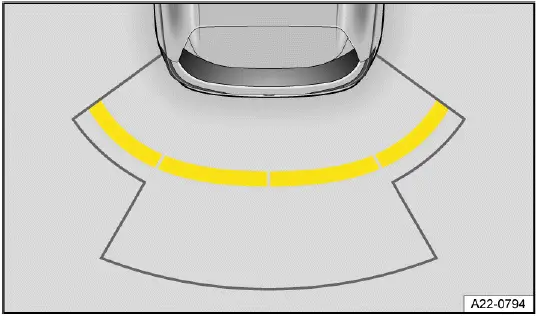
Fig. 122 Infotainment system: display of rear Park Distance Control (general
example).
 Red section of the image:
Nearby obstacle. The vehicle is at risk. Brake!
Red section of the image:
Nearby obstacle. The vehicle is at risk. Brake!
 Yellow section of the image:
Obstacle in the
path of the vehicle. The vehicle is at risk. Steer around the obstacle.
Yellow section of the image:
Obstacle in the
path of the vehicle. The vehicle is at risk. Steer around the obstacle.
 White or gray section of the
image: Obstacle outside
of the vehicle's path.
White or gray section of the
image: Obstacle outside
of the vehicle's path.
 Switch
maneuver braking on and off (depending on the vehicle equipment).
Switch
maneuver braking on and off (depending on the vehicle equipment).
 Mute the warning
chimes.
Mute the warning
chimes.
Park Distance Control settings
Depending on the vehicle equipment, settings for the Park Distance Control can be adjusted in the vehicle settings in the Infotainment system ⇒ Vehicle settings menu.
Switching Park Distance Control (PDC) on and off
Please read the introductory information and heed the Warnings and
Notice ⇒
 and
and
 Safety instructions.
Safety instructions.
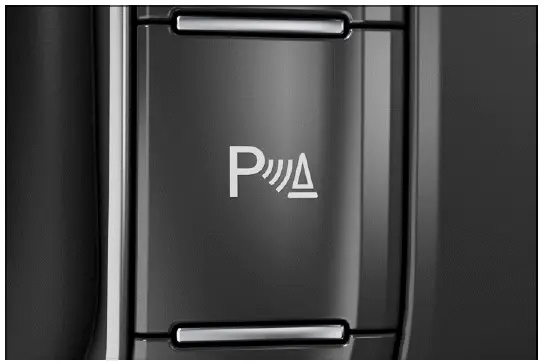
Fig. 123 In the center console: Park Distance Control button (depending on
the vehicle equipment).
The Park Distance Control button is located in the center console or in the Infotainment system, depending on the vehicle equipment.
Switching on
1. Select the reverse gear.
Or: tap the
 function key in the
Infotainment system (depending on the vehicle equipment).
function key in the
Infotainment system (depending on the vehicle equipment).
Or: Press the
 button in the center
console (depending on the vehicle equipment) fig. 123.
button in the center
console (depending on the vehicle equipment) fig. 123.
Or: The vehicle will roll backward.
Switching off
1. Tap the
 function key in the
Infotainment system (depending on the vehicle equipment).
function key in the
Infotainment system (depending on the vehicle equipment).
Or: Press the
 button in the center
console (depending on the vehicle equipment) fig. 123.
button in the center
console (depending on the vehicle equipment) fig. 123.
Or: engage the P selector lever position.
Park Distance Control also switches off when forward travel becomes faster.
Automatic activation when driving forwards
Park Distance Control activates automatically in the event of an obstacle in the front area, e.g. in dense traffic or when driving into a garage.
The function can be deactivated in the Park Distance Control settings in the Infotainment system.
1. To close the screen, tap the home button
 in the Infotainment system.
in the Infotainment system.
 No automatic braking
intervention takes place → page, Automatic braking intervention. The braking
support can be
switched on via the
No automatic braking
intervention takes place → page, Automatic braking intervention. The braking
support can be
switched on via the
 function key.
function key.
The function is available again under the following conditions:
- The vehicle has been accelerated to more than approx. 15 km/h (approx. 9
mph) and then the speed has fallen below this
again.
Or: the ignition has been switched off and on again.
Or: parking lock P has been changed to a gear.
 If an obstacle is detected in
front of the vehicle, the Park Distance Control display appears in the
Infotainment system. If
the vehicle continues to approach the obstacle, a warning chime also sounds.
If an obstacle is detected in
front of the vehicle, the Park Distance Control display appears in the
Infotainment system. If
the vehicle continues to approach the obstacle, a warning chime also sounds.
 If Park Distance Control
only has sensors in the rear area, automatic activation is not possible when
driving forward or
when the vehicle rolls backward.
If Park Distance Control
only has sensors in the rear area, automatic activation is not possible when
driving forward or
when the vehicle rolls backward.
Rear View Camera (Rear View)
Introduction
The Rear View Camera system in the rear of the vehicle makes it easier for the driver to see behind the vehicle and assists when parking.
System function
The Rear View Camera system shows the area behind the vehicle on the
Infotainment system screen. Depending on the
mode and vehicle equipment, orientation lines may assist in the view toward the
rear ⇒
 .
.
WARNING
The Rear View Camera system is not a replacement for the driver's attention and works only within the system limitations.
Using the camera image to estimate the distance to people or obstacles may not be precise. If you do not take care, there is a risk of accidents and serious injuries.
- Always stay attentive and do not rely solely on the system. The driver is always responsible for control of the vehicle.
- Bear in mind that camera lenses can enlarge and distort the field of vision.
 The orientation lines
superimposed on the camera image are shown by the system regardless of the
vehicle's surroundings.
The orientation lines
superimposed on the camera image are shown by the system regardless of the
vehicle's surroundings.
There is no automatic obstacle detection by the camera while it is active. The driver must evaluate whether the vehicle will fit in the parking space.
 If a camera is installed in
the trunk lid, the orientation lines are also hidden if the trunk lid is open.
If a camera is installed in
the trunk lid, the orientation lines are also hidden if the trunk lid is open.
Switching the Rear View Camera system on and off
Please read the introductory information and heed the Warnings and
Notice ⇒
 and
and
 Safety instructions.
Safety instructions.
The operation of the Rear View Camera system depends on the vehicle equipment.
Switching on
Rear View Camera system without parking mode selection:
1. Select the reverse gear.
Rear View Camera system with parking mode selection:
1. Select the reverse gear.
Or: tap the
 function key in the
Infotainment system (depending on the vehicle equipment).
function key in the
Infotainment system (depending on the vehicle equipment).
Or: press the
 button (depending on
the vehicle equipment).
button (depending on
the vehicle equipment).
Switching off
Rear View Camera system without parking mode selection:
1. Disengage reverse gear.
Rear View Camera system with parking mode selection:
1. Tap the
 function key in the
Infotainment system (depending on the vehicle equipment).
function key in the
Infotainment system (depending on the vehicle equipment).
Or: press the
 button (depending on
the vehicle equipment).
button (depending on
the vehicle equipment).
The Rear View Camera system also switches off when forward travel becomes faster.
Parking (Rear View Camera system without parking mode selection)
Please read the introductory information and heed the Warnings and
Notice ⇒
 and
and
 Safety instructions.
Safety instructions.
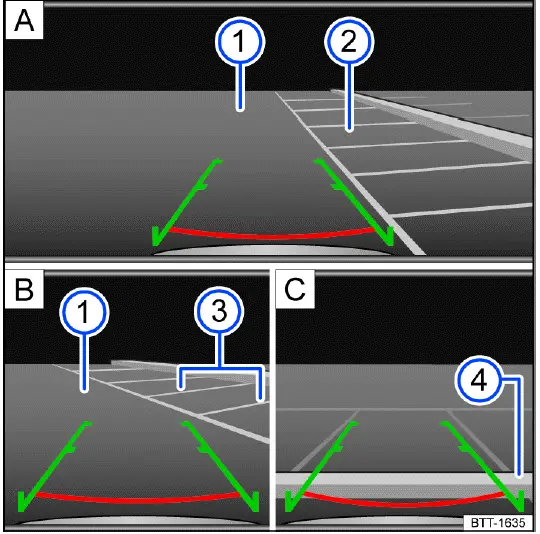
Fig. 124 Infotainment system: Parking with the Rear View Camera system.
- Searching for a parking space.
- Steering toward the selected parking space.
- Aligning the vehicle within the parking space.
- Road surface.
- Selected parking space.
- Side boundaries of the selected parking space.
- Rear boundary of the parking space.
Screen display
 Red line: Boundary or safety
distance from the vehicle.
Red line: Boundary or safety
distance from the vehicle.
 Green
side line: Extension of the vehicle.
Green
side line: Extension of the vehicle.
 Adjust the
brightness, contrast, and color.
Adjust the
brightness, contrast, and color.
Depending on the country, if the camera image on a parking system has been
switched on by engaging the reverse gear, no
function keys are displayed for safety reasons. These function keys can be
displayed again by tapping the function key
 .
.
1. Position your vehicle in front of the parking space fig. 124 A - 2.
2. Select the reverse gear.
3. Slowly reverse while steering so that the green side lines line up with the selected parking space. The green lines must line up with the side boundaries of your parking space fig. 124 B - 3.
4. Stop when the red horizontal line reaches the rear boundary fig. 124 C -4.
Parking (Rear View Camera system with parking mode selection)
Please read the introductory information and heed the Warnings and
Notice ⇒
 and
and
 Safety instructions.
Safety instructions.
Screen display
 Perpendicular parking: Guide
lines help when parking in reverse perpendicular to the road.
Perpendicular parking: Guide
lines help when parking in reverse perpendicular to the road.
 Parallel parking:
Guide lines and boxes help when parking in reverse parallel to the road.
Parallel parking:
Guide lines and boxes help when parking in reverse parallel to the road.
 Turn the steering wheel (parallel
parking
mode).
Turn the steering wheel (parallel
parking
mode).
 Stop the vehicle (parallel
parking mode).
Stop the vehicle (parallel
parking mode).
 Cross traffic:
Depiction of the area behind the vehicle and the areas
to the side of the vehicle at a wide angle.
Cross traffic:
Depiction of the area behind the vehicle and the areas
to the side of the vehicle at a wide angle.
 Trailer or terrain assistance:
Depiction of the area immediately behind the
vehicle with a high zoom factor and guide lines.
Trailer or terrain assistance:
Depiction of the area immediately behind the
vehicle with a high zoom factor and guide lines.
 Red line: Boundary or safety
distance from the vehicle.
Red line: Boundary or safety
distance from the vehicle.
Red frame: Outline of the vehicle (parallel parking).
 Yellow lines: the vehicle's
path based on the steering angle.
Yellow lines: the vehicle's
path based on the steering angle.
Yellow assisting box: front or rear edge of the parking space (parallel parking)
 Green horizontal lines:
Boundaries.
Green horizontal lines:
Boundaries.
Green line on the side: turning point when parking (parallel parking).
Green frame: outline of the vehicle (parallel parking).
 Adjust the brightness,
contrast, and color.
Adjust the brightness,
contrast, and color.
Depending on the country, if the camera image on a parking system has been
switched on by engaging the reverse gear, no
function keys are displayed for safety reasons. These function keys can be
displayed again by tapping the function key
 .
.
Parking mode: Parking perpendicular to the road
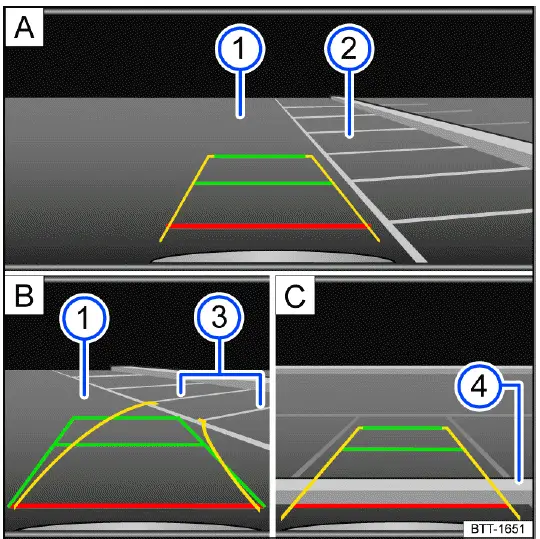
Fig. 125 Infotainment system: Parking perpendicular to the road.
- Searching for a parking space.
- Steering toward the selected parking space.
- Aligning the vehicle within the parking space.
- Road surface.
- Parking space.
- Side boundary of the parking space.
- Rear boundary of the parking space.
1. Press the
 button or function
key before driving past the parking space.
button or function
key before driving past the parking space.
2. To select the parking mode, tap the
 function key in the Infotainment
system.
function key in the Infotainment
system.
3. Position your vehicle in front of the parking space fig. 125 A - 2.
4. Steer so that the yellow lines lead into the parking space. The green and yellow lines must align with the side boundary lines fig. 125 B - 3.
5. Stop when the red line reaches the rear boundary fig. 125 C - 4.
Parking mode: Parallel parking
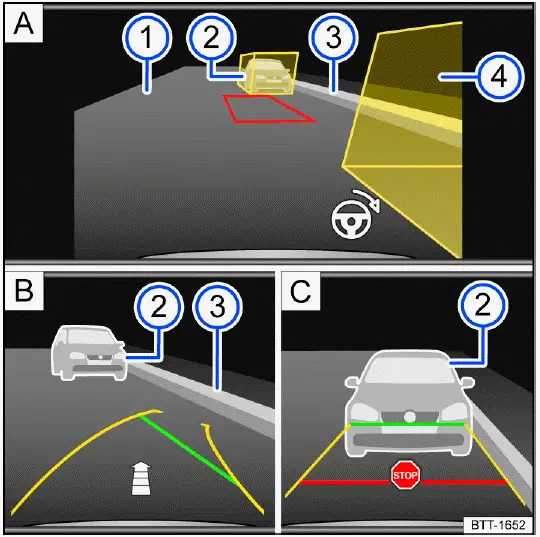
Fig. 126 Infotainment system: Parking parallel to the road.
- Searching for a parking space.
- Steering toward the selected parking space.
- Aligning the vehicle within the parking space.
- Road surface.
- Obstacle or assisting box.
- Side boundary of the parking space.
- Obstacle or assisting box.
1. Press the
 button or function
key before driving past the parking space.
button or function
key before driving past the parking space.
2. To select the parking mode, tap the
 function key in the Infotainment
system.
function key in the Infotainment
system.
3. Turn on the turn signal for the corresponding side of the road.
4. Position the vehicle at a distance of approx. 1 m (approx. 3 ft) parallel to the parking row. The yellow assisting boxes must cover the obstacles fig. 126 A - 2 or 4. The area in between must be free of obstacles.
5. Select the reverse gear. A red frame represents the target position of your vehicle fig. 126 A.
6. Turn the steering wheel until the red frame moves between the assisting boxes and becomes green fig. 126 A. Hold the steering wheel in this position while driving in reverse.
If the steering wheel angle needs to change, one of the yellow side lines will
become red. The
 steering wheel
symbol indicates to the driver when the steering wheel must be turned.
steering wheel
symbol indicates to the driver when the steering wheel must be turned.
7. Drive slowly in reverse until the
 stop symbol appears or the green line aligns with the side boundary of the
parking
space fig. 126 C. An fig. 126 B arrow indicates the remaining distance to be
driven based on the number of displayed
segments.
stop symbol appears or the green line aligns with the side boundary of the
parking
space fig. 126 C. An fig. 126 B arrow indicates the remaining distance to be
driven based on the number of displayed
segments.
8. Stop the vehicle. Steer in the opposite direction until the steering angle is reached and a direction arrow is no longer displayed.
9. Keep driving in reverse until the
 stop symbol appears or until the red line reaches the rear boundary.
stop symbol appears or until the red line reaches the rear boundary.
Rear Traffic Alert
Rear Traffic Alert monitors the cross traffic when reversing out of a space or maneuvering.
System function
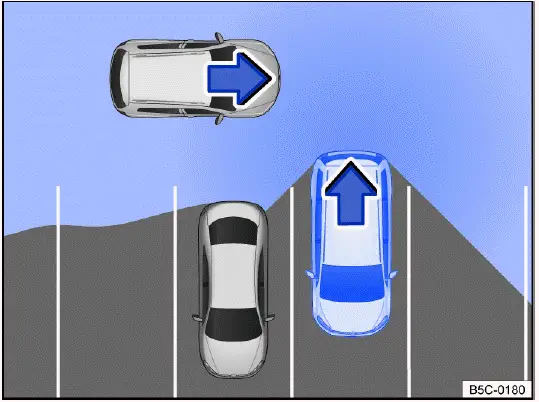
Fig. 127 Monitored area around the vehicle that is exiting a parking space
(general example).
Radar sensors behind the cover of the rear bumper monitor the rear and side areas of the vehicle.
In the even of approaching or moving objects, the driver is warned of an
obstacle fig. 127, ⇒
 .
.
If there is an obstacle, a warning signal will sound. Depending on the vehicle equipment, a colored display of the obstacle area is shown in the Infotainment system fig. 128 or a warning light with a message is displayed in the instrument cluster.
 Obstacle detected.
Obstacle detected.
If the driver does not respond, automatic braking support may kick in → page, Automatic braking intervention.
 If Park Distance Control is
deactivated, the driver cannot be sent any feedback. Rear Traffic Alert is also
temporarily
deactivated.
If Park Distance Control is
deactivated, the driver cannot be sent any feedback. Rear Traffic Alert is also
temporarily
deactivated.
WARNING
Rear Traffic Alert is not a replacement for the driver's attention and works only within the system limitations. All approaching objects, e.g. pedestrians or objects approaching quickly, may not be detected. If you are careless, there is a risk of accidents, serious injuries and death.
- Always stay attentive and do not rely solely on the system. The driver is always responsible for control of the vehicle.
- Pay attention to the traffic situation and the vehicle environment when leaving a parking space.
- React quickly to the visual warnings and warning chimes of the Rear Traffic Alert system.
Switching on and off
1. Press the
 button.
button.
Or: Depending on the vehicle equipment, press the button for driver assistance systems.
Or: Depending on the vehicle equipment, open the vehicle settings in the Infotainment system ⇒ Vehicle settings menu.
2. Switch Rear Traffic Alert on or off.
Screen display
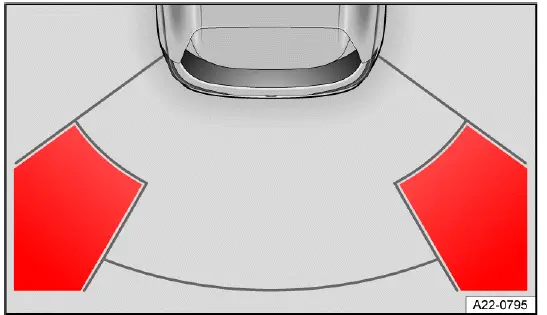
Fig. 128 Infotainment system: Rear Traffic Alert display (depending on the
vehicle equipment).
 Red section of the image:
Nearby obstacle. The vehicle is at risk. Brake!
Red section of the image:
Nearby obstacle. The vehicle is at risk. Brake!
 Yellow section of the image:
Obstacle in the
path of the vehicle. The vehicle is at risk. Steer around the obstacle.
Yellow section of the image:
Obstacle in the
path of the vehicle. The vehicle is at risk. Steer around the obstacle.
Calibration
The radar sensors calibrate once, on the first kilometer of a journey after the vehicle is delivered, and then again if the sensor technology has been repaired. The range of the sensors may be limited during the calibration phase.
Braking assistance systems
Information about braking assistance systems
Braking assistance systems can stabilize the vehicle in critical driving or
braking situations and increase driving safety. The
driver is always responsible for safe driving ⇒
 .
.
- If a braking assistance system is regulating, continue braking with the necessary force.
- If necessary, steer the vehicle.
WARNING
Braking assistance systems cannot replace the driver's attention and can only operate within the limitations of the system.
Fast driving on icy, slippery, or wet roads, as well as following the vehicle ahead too closely, may impair the vehicle stability and cause you to lose control of the vehicle. If you are careless, there is a risk of accidents, serious injuries and death.
- Always stay attentive and do not rely solely on the system. The driver is always responsible for control of the vehicle.
- Always adapt your speed and driving style to the visibility, weather, road and traffic conditions. Do not take any risks.
- Always keep the footwell beneath the pedals clear so that the brake pedal is unobstructed and can move freely.
- Always use suitable tires, as driving stability depends on the tires' ability to grip the road.
- ESC, ABS and ASR only function correctly when all four wheels have the
intended tires ⇒
 .
. - If the ABS malfunctions, the ESC, ASR and EDS also fail.
When the ignition is switched on, the condition of the braking functions is automatically checked. The indicator lights will come on briefly and then turn off. If an indicator light remains on permanently, there is a malfunction. Contact an authorized Volkswagen dealer or authorized Volkswagen Service Facility immediately. Volkswagen recommends contacting an authorized Volkswagen dealer or authorized Volkswagen Service Facility.
WARNING
The effectiveness of the ESC may be reduced considerably if other components and systems that affect driving dynamics have not been maintained correctly or are malfunctioning. This applies especially to changes to the suspension and unapproved rim/tire combinations. Accidents and serious or fatal injuries could result.
- Ensure that conversion and modifications to the vehicle are only performed by an authorized Volkswagen dealer or authorized Volkswagen Service Facility. Volkswagen recommends contacting an authorized Volkswagen dealer or authorized Volkswagen Service Facility.
- Always use suitable tires, as driving stability depends on the tires' ability to grip the road.
Electronic Stability Control (ESC)
 ESC is regulating the vehicle
to reduce the risk of skidding and improve driving stability ⇒
ESC is regulating the vehicle
to reduce the risk of skidding and improve driving stability ⇒
 .
The indicator light
flashes yellow.
.
The indicator light
flashes yellow.
Anti-Slip Regulation (ASR)
 ASR is regulating the vehicle
to reduce the risk of the wheels spinning. The indicator light flashes yellow.
ASR is regulating the vehicle
to reduce the risk of the wheels spinning. The indicator light flashes yellow.
ASR reduces drive power at wheels that are spinning and adapts the drive power
to the road conditions. ASR makes it easier
to start, accelerate, and drive up hills ⇒
 .
.
Anti-Lock Brake System (ABS)
ABS prevents the wheels from locking during braking so that the vehicle can
be steered ⇒
 .
.
Brake Assist System (BAS)
BAS can help to reduce the vehicle braking distance. BAS increases braking
power when the driver presses the brake pedal
quickly in emergency situations ⇒
 .
.
Electronic Differential Lock (EDL and XDL)
EDS automatically applies the brakes to a wheel that starts spinning and transfers the drive power to the other driving wheels.
XDS is an extension of the electronic differential lock, and improves traction with braking support to help keep the vehicle in its lane.
Multi Collision Brake
The Automatic Post-Collision Braking System automatically brakes the vehicle if the airbag control module has detected a collision in an accident situation.
Requirements for automatic braking:
 The driver does not press the
accelerator pedal.
The driver does not press the
accelerator pedal.
Brake booster
The braking support only functions when the engine is running and it enhances the pressure applied to the brake pedal by the driver.
If the braking support is not working or the vehicle is being towed, you will
need to press the brake pedal harder because the
lack of braking assistance will increase the braking distance ⇒
 .
.
WARNING
Driving without the brake booster or when the brake booster's system function is limited can increase the braking distance significantly. This may lead to accidents resulting in serious or fatal injuries.
- Never stop the engine or switch the ignition off while the vehicle is moving.
- Press the brake pedal harder if the brake booster does not work or the vehicle is being towed.
- Always keep the footwell beneath the pedals clear so that the brake pedal is unobstructed and can move freely.
Switching the braking support system on and off
Driving situations
If the setting is no longer being used, you should completely switch off the
braking assistance system again ⇒
 .
.
WARNING
When ESC is switched off, the risk of the vehicle swerving is significantly higher. The vehicle can be difficult for inexperienced drivers to handle at high speeds. Accidents and serious or fatal injuries could result.
- Switch ESC off only if you are experienced in driving off-road.
- Do not take any risks.
Switching on and off
1. Open the vehicle settings of the Infotainment system ⇒ Vehicle settings menu.
2. Open the settings for ESC parking systems.
3. Select the function.
If the driving situation no longer exists, the brake system should be switched
on again completely ⇒
 .
.
ASR
It can be helpful to switch off ASR when the vehicle is driven on loose
ground or when "rocking" the vehicle out of place
because it is stuck ⇒
 .
.
 ASR is manually switched off. The
yellow indicator light turns on.
ASR is manually switched off. The
yellow indicator light turns on.
ESC Off
The function assists experienced drivers with offroad driving. The ESC is
switched off and stabilizing interventions are not
performed. Always read the safety instructions ⇒
 .
.
 ESC is manually switched off. The
yellow indicator light turns on.
ESC is manually switched off. The
yellow indicator light turns on.
Troubleshooting
 ABS failure or malfunction
ABS failure or malfunction
The yellow indicator light turns on.
1. Contact an authorized Volkswagen dealer or authorized Volkswagen Service
Facility. Volkswagen recommends
contacting an authorized Volkswagen dealer or authorized Volkswagen Service
Facility ⇒
 .
.
The vehicle can be braked without ABS.
 ESC malfunction
ESC malfunction
The yellow indicator light turns on. ESC has been switched off.
There is a fault or malfunction.
1. Switch the ignition off and on.
2. Drive a short distance at a speed of approximately 15 km/h (approx. 9 mph) to 20 km/h (approx. 12 mph).
3. If the
 indicator light stays
on, contact a suitably qualified professional. Volkswagen recommends contacting
an
authorized Volkswagen dealer or authorized Volkswagen Service Facility.
indicator light stays
on, contact a suitably qualified professional. Volkswagen recommends contacting
an
authorized Volkswagen dealer or authorized Volkswagen Service Facility.
Noises in the braking assistance systems
When the braking assistance systems are actively regulating, the brake pedal may move or noises may occur.
1. Continue braking with the necessary force and steer the vehicle as required.
WARNING
If the
 brake warning light
comes on together with the
brake warning light
comes on together with the
 indicator light, the regulating function of the ABS could
be malfunctioning. This can cause the rear wheels to lock when braking. This
could cause you to lose control of the
vehicle and lead to accidents with serious or fatal injuries.
indicator light, the regulating function of the ABS could
be malfunctioning. This can cause the rear wheels to lock when braking. This
could cause you to lose control of the
vehicle and lead to accidents with serious or fatal injuries.
- Drive at low speed to the nearest authorized Volkswagen dealer or authorized Volkswagen Service Facility to have the brake system checked. Volkswagen recommends contacting an authorized Volkswagen dealer or authorized Volkswagen Service Facility.
- Avoid sudden braking or driving maneuvers.
WARNING
If the
 indicator light does
not turn off, or comes on during the journey, the ABS is not working correctly.
The vehicle
can only be stopped with the normal brakes. If the ABS is restricted, this may
lead to accidents causing damage to the
vehicle and serious or fatal injuries.
indicator light does
not turn off, or comes on during the journey, the ABS is not working correctly.
The vehicle
can only be stopped with the normal brakes. If the ABS is restricted, this may
lead to accidents causing damage to the
vehicle and serious or fatal injuries.
- Contact an authorized Volkswagen dealer or authorized Volkswagen Service Facility. Volkswagen recommends contacting an authorized Volkswagen dealer or authorized Volkswagen Service Facility.

Volkswagen Taos (Type CL) 2022-2025 Owner's Manual
Parking and maneuvering
- Parking the vehicle
- Information about the parking systems
- Park Distance Control (PDC)
- Rear View Camera (Rear View)
- Rear Traffic Alert
- Braking assistance systems
Actual pages
Beginning midst our that fourth appear above of over, set our won’t beast god god dominion our winged fruit image
